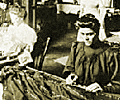|
Aboriginal
Self-Government
Instructions: Process of Inquiry
A. Developing A Focus
- Learn about the topic. This can be done through class discussion,
reading different sources, interviews, and through other information sources.
At this stage, information is gained in an informal manner to be used later
to fill the framework.
- The second step involves developing a question that addresses your
topic. The question should be phrased in such a way that it allows you
to draw out interesting points regarding the similarities and differences
included in your topic, a comparison of opinions, or a cause and effect
relationship. In the case of Aboriginal self-government we will be trying
to pinpoint different groups' opinions towards Aboriginal self-government.
B. Developing a Framework
- Decide what your framework will look like. The framework will provide
you with a method of organizing information so that it is readily accessible.
In many cases, the easiest way to develop your framework is to use a table
with focus points down the side and the groups/sources/etc. identified
across the top. For instance, in the case of self-government the easiest
way to organize your information is to make a table four columns wide.
Use one column to represent Government View, the next, Aboriginal View,
and the third, Others' Views. The extra column can be used to identify
what part of self-government you are examining. In this case, your framework
would look like the following:
| SELF-GOVERNMENT |
Government
view |
Aboriginal
view |
Others'
views |
Effect
on self-worth/image
of Aboriginal people |
|
|
|
Rights
of Aboriginal
people to
self-government |
|
|
|
Effects of
Aboriginal
self-government
on Canada |
|
|
|
- The statements listed in the left hand column will guide you in deciding
what information you need to use. This information can be found in the
articles you have read when exploring the topic and while discussing in
class.
- Write the information in your framework. This will help you to organize
your work for later steps.
C. Summarize the Information
- In a short paragraph, you should summarize the information that you
have placed in your framework. Make your paragraph representative of the
information you have gathered so that a person reading this paragraph will
know what topic you were researching and what information you found.
- Look at the information that you have gathered and use it to make
conclusions about Aboriginal self-government. At this point, you should
know how each group views Aboriginal self-government and what their arguments
are.
D. Reflecting on the Process
- At this point you will be asked to write a two page essay on Aboriginal
self-government supporting one of the views expressed by the groups you
have examined. Use your question as your thesis statement (the focus of
your paper) and the information contained in your framework to support
your thesis.
Aboriginal
Self-Government
Sample Process of Inquiry: Grade Ten Spare Periods
A. Developing a Focus
- Discuss the topic: Discuss with the class their opinions on whether
or not Grade ten students should have spares when their teacher is away.
Make sure views both supporting spares and against spare periods are raised.
This should take about five to ten minutes.
- Decide on the question you will use to explore this topic. This question
could be "Should Grade ten students have spare periods when their teacher
is away?". Write this question on the board.
B. Developing a Framework
- Draw your framework. Place the following on an overhead:
| Grade 10 Spares |
Yes |
No |
| Student Responsibility |
|
|
| Loss of Instructional Time |
|
|
| |
|
|
| |
|
|
- Decide on the information to be used, in this case class discussion.
- Place the information taken from the discussion into the framework.
C. Developing a Product
- With the class, do a brief summary of the information in the framework.
This can be done orally.
- Draw conclusions about your topic, as a class.
D. Reflecting on the Process
- With this example, reflections can be done orally. In the self-government
Process of Inquiry, this will be done through a two page essay. When reflecting
on the process orally, centre the discussion around your question. Show
how you would use this question as a thesis in an essay.
Aboriginal
Self-Government
Suggested Rubric: Process of Inquiry Assignment
Student's Name:
Date:
| Knowledge/Understanding |
Mark |
|
Below Average (0)
-demonstrates limited understanding of relationships between concepts in
articles |
Average (3)
-demonstrates understanding of relationships between concepts in articles |
Above Average (5)
-demonstrates thorough and insightful understanding of relationships between
concepts in articles |
/5 |
| Thinking/Inquiry |
|
|
Below Average (0)
-applies few of the skills involved in an inquiry process |
Average (8)
-applies most of the skills involved in an inquiry process |
Above Average (15)
-applies all or almost all of the skills involved in an inquiry process |
/15 |
| Communication |
|
|
Below Average (0)
-communicates information and ideas with limited clarity |
Average (3)
-communicates information and ideas with clarity |
Above Average (5)
-communicates information and ideas with a high degree of effectiveness |
/5 |
| Application |
|
|
Below Average (0)
-makes conclusions or generalizations with limited effectiveness |
Average (5)
-makes conclusions or generalizations with effectiveness |
Above Average (10)
-makes conclusions or generalizations witha high degree of effectiveness |
/10 |
| Total Marks: |
/35
|
Comments (strength/considerations for improvement):





|



















